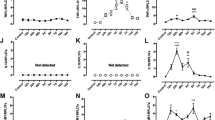Abstract
Growing melanomas invade the subcutaneous tissues. We have compared the size of tumors implanted in the subcutaneous cavities of C57BL/6 mice where inflammatory reactions were induced before the injection of 5×105 melanoma cells (B16F10 cell line). Granulocytic inflammation of the subcutaneous cavities resulted in a significant decrease in the growth of the implanted melanomas, whereas monocytic inflammation had no effect on tumor growth. We conclude that granulocytes, but not monocytes/macrophages, have anti-tumor action on melanoma that invade the subcutaneous tissues.
Similar content being viewed by others
References
Masbak, A., H. Olsson, J. Westerdahl, C. Ingvar, and N. Jonsson. 2001. Prognostic factors in invasive cutaneous malignant melanoma: A population-based study and review. Melanoma Res. 11:435–445.
Katerinaki, E., N. Zhu, R. Lalla, P. Eves, J. Haycock, G. Evans, G. Ghanem, P. Lorigan, T. Brown, and S. MacNeil. 2003. Does a wound healing environment and the inflammation associated with it promote melanoma invasion? (PP-16) Pigment. Cell Res. 16:598.
Schaider, H., M. Oka, T. Bogenrieder M. Nesbit, K. Satyamoorthy, C. Berking, K. Matsushima, and M. Herlyn. 2003. Differential response of primary and metastatic melanomas to neutrophils attracted by IL-8. Int. J. Cancer 103:335–343.
Sedwick, A. D., Y. M. Sin, J. C. Edwards, and D. A. Willoughby. 1983. Increased inflammatory reactivity in newly formed lining tissue. J. Pathol. 141:483–495.
Raz, A., G. Levine, and Y., Khomiak. 2000. Acute local inflammation potentiates tumor growth in mice. Cancer Lett. 148:115–120.
Ames, B. M., L. Swirsky Gold, and W. C. Willet. 1995. The causes and prevention of cancer. Proc. Natl. Acad. Sci. 92:5258–5265.
Lozupone, F., F. Luciani, M. Venditti, L. Rivoltini, S. Pupa, G. Parmiani, F. Belardelli, and S. Fais. 2000. Murine granulocytes control human tumor growth in SCID mice. Int. J. Cancer 87:569–573.
Di Carlo, E., G. Forni, P. Lollini, M. P. Colombo, A. Modesti, and P. Musiani. 2001. The intriguing role of polimorphonuclear neutrophils in antitumor reactions. Blood 97:339–345.
Midorikawa, Y., T. Yamashita, and F. Sendo. 1990. Modulation of the immune response to transplanted tumors in rats by selective depletion of neutrophils in vivo using a monoclonal antibody: Abrogation of specific transplantation resistance to chemical carcinogen-induced syngeneic tumors by selective deplection of neutrophils in vivo. Cancer Res. 50:6243–6247.
Matsumoto, Y., I. Saiki, J. Murata, H. Okuyama, M. Tamura, and I. Azuma. 1991. Recombinant human granulocyte colony-stimulating factor inhibits the metastasis of hematogenous and non-hematogenous tumors in mice. Int. J. Cancer 49:444–449.
Chen, Y. L., S. H. Chen, J. Y. Wang, and B. C. Yang. 2003. Fas ligand on tumor cells mediates inactivation on neutrophils. J. Immunol. 171:1183–1191.
Van Spriel, A. B., H. H. Van Ojik, A. Bakker, M. J. Jansen, and J. G. Van de Winkel. 2003. Mac-1 (CD11b/CD18) is crucial for effective Fc receptor-mediated immunity to melanoma. Blood 101:253–258.
Dissemond, J., T. K. Weimann, L. A. Schneider, A. Schneeberger, K. Scharffetter-Kochnek, M. Goos, and S. N. Wagner. 2003. Activated neutrophils exert anti-tumor activity against human melanoma cells: Reactive oxygen species-induced mechanisms and their modulation by granulocyte-macrophage-colony-stimulating factor. J. Invest. Dermatol. 121: 936–938.
Author information
Authors and Affiliations
Corresponding author
Rights and permissions
About this article
Cite this article
Costa, M.M., Águas, A.P. Inflammatory Granulocytes Decrease Subcutaneous Growth of Melanoma in Mice. Inflammation 28, 355–357 (2004). https://doi.org/10.1007/s10753-004-6646-7
Issue Date:
DOI: https://doi.org/10.1007/s10753-004-6646-7




